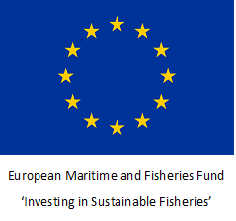Saving the Sparling
Sparling were found in various Scottish rivers in the past but died out due to over-fishing, pollution and / or the building of barriers preventing them from reaching suitable spawning habitat. In Scotland they are now one of our rarest fish, apparently only remaining in the Cree, Forth and Tay. For many years GFT has studied the local Sparling population, worked to protect them and informed the local community about these wonderful fish.
Sparling (Osmerus eperlanus), also known as smelt or the cucumber fish, are a relatively small fish growing up to 30cm long. They have an adipose fin, appear grey-green in the water and have a distinct cucumber-like smell. They are an anadromous species, meaning they spend most of their lives in the estuaries but require freshwater to complete their lifecycle by migrating en masse into freshwater over a few days each spring. They utilise the incoming high spring tides, as they are relatively weak swimmers, to reach the upper tidal limit of the River Cree to spawn. Their sticky eggs adhere to substrate surface and water weed where they hatch after a few weeks. After hatching, juvenile Sparling are then carried downstream to the estuaries to feed and grow before returning as adults to spawn after a few years.
Sparling were once a common species found in various Scottish rivers but have suffered significant declines due to over-fishing, pollution or the building of impassable barriers. Historical records show that sparling were heavily netted with some years recording up to 6 tonnes being caught in the Cree, that roughly equates to 50,000 fish. Alongside commercial fishing, locals would regularly head down to the river during their spawning migration to collect a few buckets for their annual tasty dinner treat.
In Scotland they are now one of our rarest fish, only reported to remain in the Cree, Forth and Tay. There were once 15 known populations of Sparling occurring in Scottish rivers; Almond, Annan, Bladnoch, Clyde, Cree. Dee, Esk. Fleet, Forth, Girvan, Lochar, Nith, Stinchar, Tay and Urr. Sparling are protected under the Wildlife & Countryside Act 1981 and are also included in the UK and Dumfries and Galloway Biodiversity Action Plan Priority Species list. Since 1991 the Lower Cree has been designated as an SSSI to protect this rare fish's vital spawning ground.
GFT has studied Sparling for many years to consider what may be limiting their numbers. It is important to understand their life cycle and habitat use when considering how to protect them. Site condition monitoring has been used to monitor the health of the population.
GFT Sparling projects over the years have included investigating maximum swimming speed of Sparling, predation and the introduction of fertilised Sparling eggs into a neighbouring river (Water of Fleet) to try and re-establish a population.
In 2021 GFT was commissioned by Natural England to write the 'European smelt (Osmerus eperlanus (L.)) Recovery Management Plan for the Solway Firth Marine Conservation Zone (MCZ)'. The completed report can be downloaded here https://publications.naturalengland.org.uk/file/6305832007630848
The Saving the Sparling project was a GFT project delivered in 2018 - 2019 through the employment of two interns. The interns studied the local Sparling population in the River Cree as well as educating and engaging with the local community about this wonderful fish.
The key deliverables of the project were:
- To collect environmental data to predict the arrival of the Sparling to spawn
- Completing regular checks for spawning in the lower river
- Involve volunteers in the project
- To collect a sample of Sparling during a spawning event
- Collecting biological data from sampled Sparling
- Engage with the local community to record local historical information
- Raise awareness of Sparling in the local community and further afield
- Deliver a Sparling focused project in local schools
In terms of community engagement and education, the ‘Sparling Goes To School’ programme was run to educate local schools about the ecology of Sparling which included pupils meeting real live Sparling! A range of dissemination material was produced including display boards, leaflets and a short film. The material included local historical information collected during public engagement events in Newton Stewart and Gatehouse of Fleet. Throughout 2018 local filmmaker John Wallace filmed the project work and created a short documentary-style film which includes footage of the Sparling on the spawning grounds, you can watch the informative film by clicking on the link at the bottom of the page.
Local volunteers assisted the interns on various aspects of the project, including recording the presence of known Sparling predators where volunteers had the opportunity to learn new skills in bird identification. Volunteers also had the opportunity to learn more about Sparling along the banks of the River Cree and the River Urr, learning more about their ideal habitat, signs of the Sparlings' arrival and to observe Sparling (even testifying they smell of cucumber).
Cumulatively the interns successfully delivered all aspects of the project including predicting the arrival of the Sparling, sampling Sparling, educating local children, engaging with locals and involving volunteers. Most importantly this project has successfully increased awareness about rare Sparling in the local community and even further afield, receiving national coverage on BBC Radio Scotland’s Out of Door programme and in the national newspaper the Scotsman.
Click this link to see the Sparling Film produced as part of this project by local filmmaker John Wallace.



Downloads
Gallery
Latest News
6 month paid internship with GFT
A paid internship is available from September 2024 until end of February 2025 (26 weeks) to work with Galloway Fisheries Trust on the Solway Invasive Non Native Species INNS Control and Knowledge programme Phase 2 (advertised a few weeks ago but post was not filled).
Annan Riparian Restoration Network
GFT has been successful in securing funding from the FIRNS scheme to develop a large-scale habitat restoration project for the River Annan catchment.
Improving fish passage and river flow below Tongland Dam
SEPA have been undertaking a review of the current CAR license which the Galloway Hydro Scheme operates under.